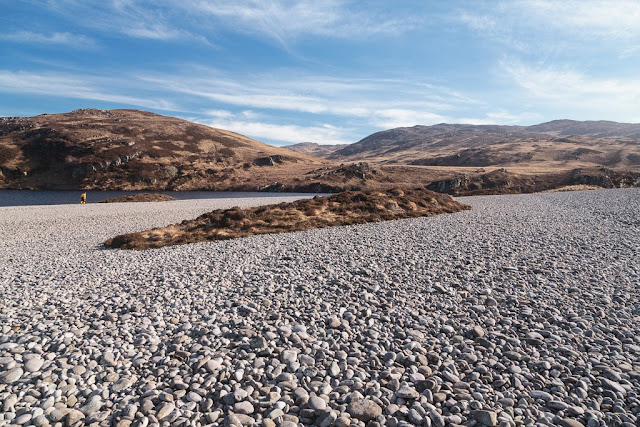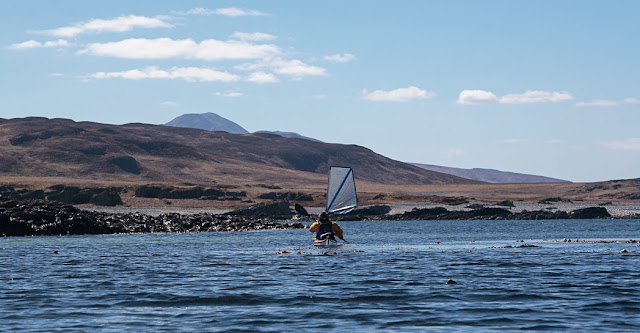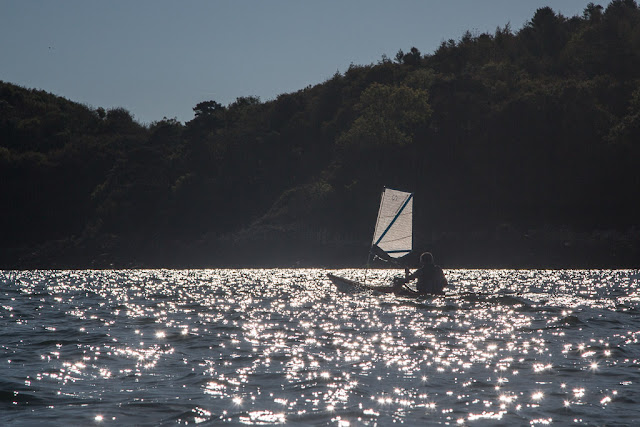On our way we passed many more basalt dykes which ran down the hillside into the sea. This one looked like Chief Running Deer of Jura complete with war bonnet.
At this turquoise lagoon the waters were...
...crystal clear and we stopped on its...
...sands below...
...an incredible raised beach which soared up towards the slopes of Beinn an Oir. We had spotted some well seasoned driftwood which had been cast high above the high watermark.
We gathered arm fulls before returning to the boats. We were bound for Cruib Lodge at the head of West Loch Tarbert and we knew there would be little wood there.
The view of the Paps of Jura gradually changed as we entered West Loch Tarbert and started paddling east.
Ben More on Mull rose above the Ruantallain peninsula on the north side of the loch as Hazel Ann CN373, a creel boat from Port Askaig motored out of the loch.
Glen Batrick, a gap in the hills behind the south shore opened up a view of the Paps of Jura again.
At the mouth of the glen lies Glenbatrick house. It is locally pronounced Glenabatrick after the original name Glenabedrig. It belongs to Viscount Astor who is David Cameron's stepfather in law. The Camerons have spent several holiday's here, far from the pressures of Westminster.
From Glenbatrick we paddle sailed east up the outer loch in an...
...increasing NW wind. The combination of wind...
...sun and spray made for some incredible paddle sailing conditions but we took a break from the fun at...
...Rubha nam Meann (headland of the young goat) to explore one of the most intriguing locations on the British coastline.
The cobbles on this beach rise high above the current HW mark and it is one of the best examples of a raised beach in Britain. I have been here many times before but it was Ian and Mike's first visit. As I had raised their expectations and built the place up, I hoped they would not be disappointed.
As you climb towards the summit...
...of the beach you are stepping back in time until you reach the...
...summit of the beach where the tide last went out some 10,000 years ago.
It is like a time machine because despite the passage of the millennia, the cobbles are as clean as if the tide had just receded that morning. Since the great weight of ice over the land melted, this part of the Earth's crust under Scotland has been steadily rising from the magma below.
There are so many cobbles here that they have created a dam across the glen behind which retains a fresh water loch, Lochan Maol an t-Sornaich, (lochan of the rounded hill of the boulders). No river flows from the loch. Its waters seep gently to the sea through the spaces between the cobbles.
Near the summit of the beach the largest cobbles are to be found and on some of the oldest specimins ancient colonies of lichen have formed.
There are only a few patches of vegetation that have become established on the beach and when...
...seen from above (photo by me September 2009) they are situated most harmoniously within the landscape showing that Slartibartfast had a good understanding of the principles of Feng Shui. Indeed he was probably the founder of this ancient art which symbolises the harmony between wind and water.
...we realised how privileged we were to be able to visit this special place that few of our countrymen are even aware of. The "paths" across the cobbles were not made by the feet of men but are where countless generations of deer have picked their way carefully across the beach.
Reluctantly we left this special place where time has stood still.





























































